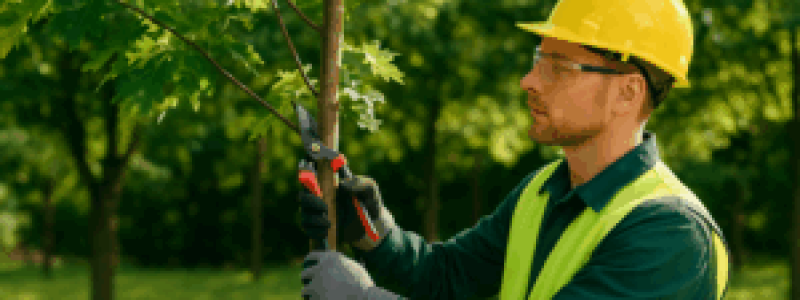The foundation of a strong and resilient tree is often established in its earliest years. How a young tree is pruned determines its structure, health, and longevity. Proper care at this stage reduces the risk of structural weakness, disease, and costly interventions later in life. Professional tree pruning services play a central role in guiding young trees toward balanced growth, ensuring they remain assets to landscapes for decades to come. Arbor Plus specializes in applying time-tested practices that combine scientific understanding with practical experience.
Why Early Pruning Matters
Young trees respond more readily to pruning than mature specimens. Their growth patterns can be shaped to promote a strong central leader, evenly spaced branches, and sound root-to-crown balance. Without attention, structural flaws such as crossing branches, codominant stems, or weak attachments may develop. These flaws can later compromise stability and shorten the tree’s lifespan.
Pruning at an early stage is less invasive, less costly, and more effective. Tree pruning services not only improve a tree’s form but also reduce the likelihood of hazards such as falling limbs or storm-related failures.
Establishing a Central Leader
One of the primary goals of pruning young trees is to encourage a dominant central leader. This vertical stem provides stability and supports even distribution of branches. Allowing multiple leaders to compete often results in narrow angles and weak unions prone to splitting. Professional arborists selectively remove competing stems, guiding growth into a strong, upright form.
Creating Well-Spaced Scaffold Branches
Scaffold branches form the permanent framework of a tree. They should be evenly distributed around the trunk and spaced vertically to allow adequate airflow and sunlight. Crowded or poorly placed branches increase the risk of disease and inhibit healthy growth. Through careful thinning and removal, arborists help establish a framework that will support the canopy throughout the tree’s life.
Addressing Crossing and Rubbing Branches
Branches that cross or rub against one another create wounds that invite pests and disease. Early correction through pruning prevents these problems from developing into larger structural issues. Tree pruning services focus on removing competing limbs while maintaining a natural shape.
Timing the Pruning Correctly
The timing of pruning plays an important role in how well a tree recovers. For most young trees, late winter or early spring, before bud break, is ideal. This timing reduces stress and encourages vigorous new growth. Summer pruning may be necessary in cases where rapid correction is required, such as removing hazardous limbs. Arborists weigh the specific species, local climate, and condition of the tree to determine the optimal timing.
Avoiding Over-Pruning
While pruning is beneficial, excessive removal of foliage can weaken a young tree. Leaves are essential for photosynthesis, and removing too many at once limits energy production. A general guideline is to avoid removing more than one-quarter of the tree’s canopy in a single season. Professional tree pruning services apply restraint, ensuring that growth is guided without compromising vitality.
Making Proper Cuts
The way a cut is made influences how a tree heals. Cuts should be made just outside the branch collar, where the branch meets the trunk. This area contains specialized cells that aid in sealing the wound. Flush cuts or stubs interfere with healing and can create entry points for decay. Arborists are trained in the precise techniques needed to protect tree health while shaping structure.
Encouraging Root-to-Crown Balance
Pruning is not limited to shaping the canopy. Arborists also consider the relationship between the crown and the root system. A tree with excessive top growth compared to its roots is more likely to suffer stress during droughts or high winds. By moderating canopy size, pruning supports a stable and sustainable balance.
Monitoring and Adjusting Over Time
Pruning is not a one-time event but part of an ongoing process. As young trees grow, periodic evaluations are necessary to refine structure and address emerging concerns. Tree pruning services include scheduled visits that adapt techniques to the tree’s changing needs. This ongoing attention ensures steady development and reduces the need for drastic interventions in later years.
The Role of Professional Tree Pruning Services
Although some property owners attempt to prune young trees themselves, professional care provides several advantages. Arborists bring specialized knowledge of tree biology, safety practices, and long-term planning. They recognize subtle signs of stress, disease, or imbalance that are often overlooked. Arbor Plus combines this expertise with practical tools and methods that prioritize the health and safety of each tree.
By engaging professional tree pruning services, property owners invest in the long-term value of their landscapes. Healthy, well-structured trees contribute to aesthetics, shade, property value, and ecological balance.
The Long-Term Value of Proper Pruning
Pruning young trees is both an art and a science. Done correctly, it establishes the framework for decades of health and stability. From guiding central leaders to managing canopy balance, each step contributes to long-term resilience. Arbor Plus provides comprehensive tree pruning services rooted in knowledge and experience, ensuring that young trees grow into strong, enduring fixtures of the landscape. Thoughtful care in the early years pays dividends in safety, beauty, and sustainability for generations.

